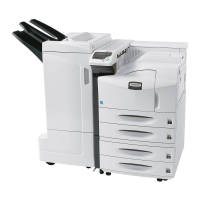Handling Paper
ADVANCED OPERATION GUIDE 1-7
Moisture Content
Moisture content is defined as the percent ratio of moisture to the dry mass
of the paper. Moisture can affect the paper’s appearance, feedability, curl,
electrostatic properties, and toner fusing characteristics.
The moisture content of the paper varies with the relative humidity in the
room. When the relative humidity is high and the paper absorbs moisture,
the paper edges expand, becoming wavy in appearance. When the relative
humidity is low and the paper loses moisture, the edges shrink and tighten,
and print contrast may suffer.
Wavy or tight edges can cause misfeeding and alignment anomalies. The
moisture content of the paper should be 4 to 6%. To ensure the proper
moisture content, it is important to store the paper in a controlled
environment. Some tips on moisture control are:
• Store paper in a cool, dry location.
• Keep the paper in its wrapping as long as possible. Rewrap paper that
is not in use.
• Store paper in its original carton. Place a pallet, etc., under the carton
to separate it from the floor.
• After removing paper from storage, let it stand in the same room as the
printer for 48 hours before use.
• Avoid leaving paper where it is exposed to heat, sunlight, or damp.
Paper Grain
When paper is manufactured, it is cut into sheets with the grain running
parallel to the length (long grain) or parallel to the width (short grain). Short
grain paper can cause feeding problems in the printer. All paper used in
the printer should be long grain.
Other Paper Properties
Porosity: Refers to the density of the paper structure; that is, how openly
or compactly the fibers are bonded.
Stiffness: Limp paper can buckle inside the printer, while paper that is too
stiff may bind. Either way the result is a paper jam.
Curl: Most paper has a natural tendency to curl in one direction. The paper
should be loaded so that the natural curl is downward, to counteract the
upward curl imparted by the printer. Printed sheets will then come out flat.
Most paper also has a top and bottom surface. Loading instructions are
usually given on the paper package.
NOTE: If the paper is considerably curled in one direction, e.g. when the
paper was used to print on one side, try to roll the paper in the opposite
direction to counteract the curl. Printed sheets will then come out flat.

